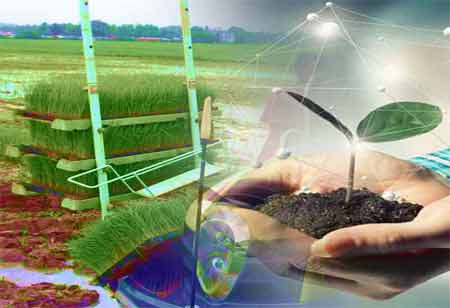Thank you for Subscribing to Agri Business Review Weekly Brief
Enhancing Peanut Crop Productivity Through Biostimulant Application
Peanut, scientifically called Arachis hypogaea, is an economically significant legume crop globally.

By
Agri Business Review | Wednesday, March 27, 2024
Stay ahead of the industry with exclusive feature stories on the top companies, expert insights and the latest news delivered straight to your inbox. Subscribe today.
Biostimulants enhance peanut productivity by optimizing nutrient management, mitigating stress, and improving yield and quality, enabling sustainable and resilient production systems.
FREMONT, CA: Peanut, scientifically called Arachis hypogaea, is an economically significant legume crop globally. It is valued for its high protein content and versatility in various food products. However, maximizing peanut crop productivity faces challenges such as soil degradation, nutrient deficiency, and environmental stresses. In recent years, the application of biostimulants has emerged as a promising strategy to enhance crop growth, yield, and stress tolerance.
Biostimulants are substances or microorganisms applied to plants or soils to enhance nutrient uptake, improve stress tolerance, and promote growth and development. Unlike fertilizers, biostimulants contain significant amounts of nutrients that exert beneficial effects through diverse mechanisms, including hormonal regulation, stimulation of metabolic processes, and modulation of microbial communities in the rhizosphere.
Benefits of Biostimulants for Peanut Crop
Enhanced Nutrient Uptake: Biostimulants enhance the efficiency of peanut plants' nutrient uptake, leading to improved nutrient availability and utilization. This is particularly beneficial in nutrient-deficient soils or under conditions of limited nutrient mobility.
Improved Stress Tolerance: Peanut crops are susceptible to various environmental stresses, including salinity and disease pressure. Biostimulants bolster the plant's natural defense mechanisms, mitigating the adverse effects of stressors and promoting resilience under challenging growing conditions.
Increased Yield and Quality: Biostimulants enhance peanut yield and quality by stimulating root growth, improving flowering and fruiting, and boosting photosynthetic efficiency. This leads to increased nut size, higher oil content, and elevated protein concentration in peanuts.
Sustainability and Environmental Compatibility: Biostimulants offer a sustainable approach to crop management. They reduce reliance on synthetic inputs and minimize adverse environmental impacts associated with conventional agricultural practices. Moreover, the use of biostimulants contributes to soil health and ecosystem resilience over the long term.
Types of Biostimulants for Peanut Crop
Humic Substances: Humic substances derived from organic matter sources such as peat, compost, and vermicompost have been shown to enhance soil fertility, improve nutrient retention, and stimulate root growth in peanut crops.
Seaweed Extracts: Seaweed extracts contain a complex mixture of bioactive compounds, including phytohormones, amino acids, and antioxidants, which promote plant growth, stress tolerance, and yield enhancement in peanuts.
Microbial Biostimulants: Beneficial microorganisms such as mycorrhizal fungi, rhizobacteria, and plant growth-promoting rhizobacteria (PGPR) can establish symbiotic relationships with peanut plants, facilitating nutrient uptake, disease suppression, and overall growth promotion.
Amino Acids and Protein Hydrolysates: Amino acids and protein hydrolysates serve as bioavailable nitrogen sources and signaling molecules, regulating various physiological processes in peanut plants and enhancing their adaptive responses to environmental stressors.
Application Strategies and Considerations
Timing and Frequency: To maximize efficacy, biostimulant application timing is aligned with key growth stages of the peanut crop, such as vegetative growth, flowering, and pos development. Split applications are beneficial under prolonged stress conditions.
Compatibility with Other Inputs: Biostimulants complement conventional fertilizers, pesticides, and other agronomic inputs to optimize overall crop management strategies. Compatibility testing ensures synergistic interactions and minimizes potential antagonistic effects.
Application Methods: Biostimulants are applied via foliar spray, soil drench, seed treatment, or fertigation, depending on the product formulation, target efficacy, and agronomic practices. Proper application techniques and equipment calibration are essential to ensure uniform coverage and efficient uptake by peanut plants.
Regulatory Compliance and Certification: As biostimulant products vary in composition and mode of action, adherence to regulatory guidelines and certification standards is essential to guarantee product safety, efficacy, and environmental sustainability. Growers should source biostimulants from reputable manufacturers and suppliers with established quality assurance protocols.
Biostimulants have the potential to enhance peanut crop productivity; further research is needed to elucidate their mechanisms of action, optimize application protocols, and evaluate their long-term impacts on soil health, crop performance, and ecosystem resilience. Integrated approaches combining biostimulants with genetic improvements, precision agriculture technologies, and sustainable management practices hold considerable promise for achieving resilient and productive peanut production systems in the face of evolving environmental challenges.
Biostimulants offer a multifaceted approach to enhancing peanut crop productivity. They provide growers with effective tools to optimize nutrient management, mitigate environmental stresses, and improve yield and quality attributes. By harnessing the benefits of biostimulants and integrating them into holistic crop management strategies, peanut producers achieve sustainable and resilient production systems that meet the demands of global food security while safeguarding environmental integrity.





